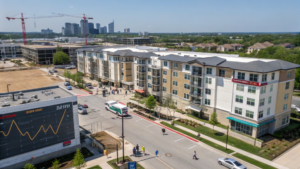When a modest apartment in Riverside, California, demands six figures just to afford housing and stay afloat, it’s clear: something’s broken. As a real estate analyst, I’ve tracked countless market cycles—but this one feels more like a warning than a rebound. Housing, once a ladder to middle-class stability, is quickly becoming a luxury good.
Table of Contents
ToggleRenters Need $100K+ to Afford Living in These 8 U.S. Cities
According to Zillow’s April 2025 data, renters now need an annual income of at least $100,000 to live comfortably in eight major metro areas—including New York City, San Francisco, Boston, Miami, and even Riverside, California. That’s based on the common rule that rent should not exceed 30% of income—or $2,500/month for someone earning six figures. This is double the number of cities requiring six-figure incomes for rent compared to pre-pandemic years, per Zillow senior economist Kara Ng. And even as mortgage rates remain high, the rental market offers little relief—average national rent is up nearly 30% since 2020, now sitting at $1,858.
Expert Insight: Why This Matters More Than Ever
1. Housing Inflation Has Outpaced Wage Growth
Since 2020, rents have risen 30%, but median income only grew 22.5%, per the Census Bureau. That math doesn’t work for renters trying to afford both housing and basic needs like food or savings.
If rent eats up $3,000 of your $8,000/month salary, how do you ever build wealth?
2. Cities Once Considered “Affordable” No Longer Are
It’s not just San Francisco or Manhattan anymore. Even Riverside, CA, once a budget alternative to L.A., now requires $102,000/year to stay below the rent burden threshold. This shift is gutting the middle class and pushing people to relocate—changing the demographic fabric of entire metros.
3. Inventory Crisis Is the Root Problem
Despite construction efforts, demand continues to outstrip supply, driving prices higher. Programs like the Low Income Housing Tax Credit exist—but experts like Rachel Fee from the NY Housing Conference say federal action remains too slow to make meaningful impact.
4. This Signals a Broader Wealth Divide
When basic shelter requires six figures, we’re no longer talking about a cost-of-living issue—we’re facing a structural affordability crisis that deepens inequality.
What Renters and Investors Should Do Now
Renters: Know Your Leverage
- Negotiate lease renewals. With broker fees being phased out in NYC and other reforms in progress, renters have more leverage than they realize.
- Consider relocation. Cities like Buffalo, NY and Oklahoma City still offer rents under $1,500, with incomes under $60K needed.
Investors: Shift Toward Workforce Housing
- Focus on Class B/C multifamily units in secondary markets where demand is steady and renters are priced out of Class A.
- Explore Build-to-Rent (BTR) as suburban sprawl pushes renters further from urban cores.
Policymakers: Accelerate Housing Incentives
- Expand programs like LIHTC and streamline permitting processes to get more units built faster.
Quick Explainer: What Is “Income Needed to Afford Rent”?
What does it mean when Zillow says you need $100K to afford rent?
It’s based on the 30% rule—where rent should take up no more than 30% of your pre-tax income. So to afford a $2,500/month rental, you’d need to earn at least $100,000/year. This metric helps benchmark housing affordability across different income brackets and cities.
Looking Ahead: Will Relief Come—or More Pressure?
How long can renters hold on before relocation, downsizing, or even cohabitation becomes a forced necessity? And if federal action remains stalled, will we see a flood of talent exit our most expensive cities? The affordability crisis is no longer a trend—it’s becoming a defining feature of American urban life.
Reader Q&A
Is renting still better than buying in these high-cost cities?
In many cases, yes—especially with mortgage rates still elevated. But over time, neither feels financially sustainable without local wage growth or more housing stock.
Can remote work solve this?
For some, yes. If you can earn a big-city salary while living in a smaller market, you can “hack” affordability—for now.
Where can I find cities with lower income requirements for rent?
Consider metros like Cleveland, Buffalo, Oklahoma City, or Pittsburgh, where needed income is often under $60,000.



